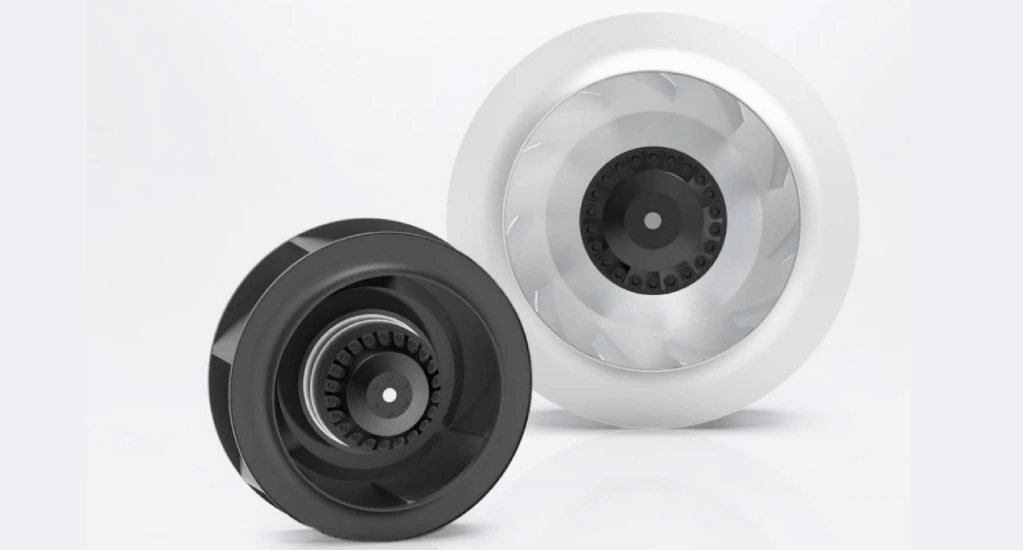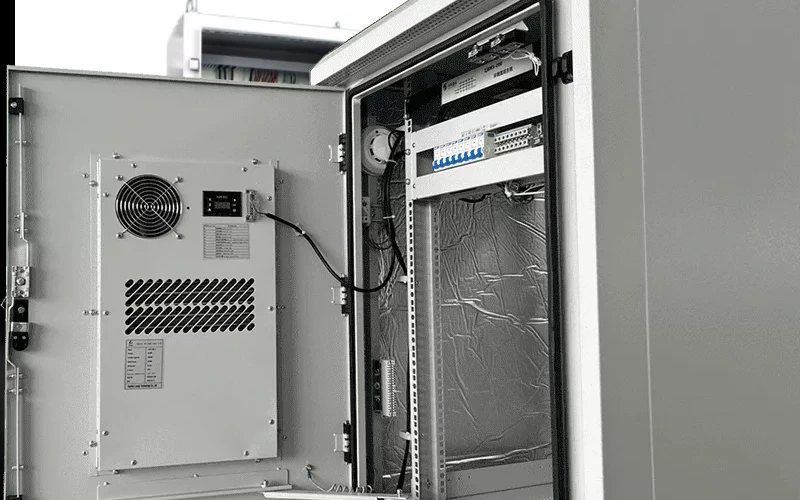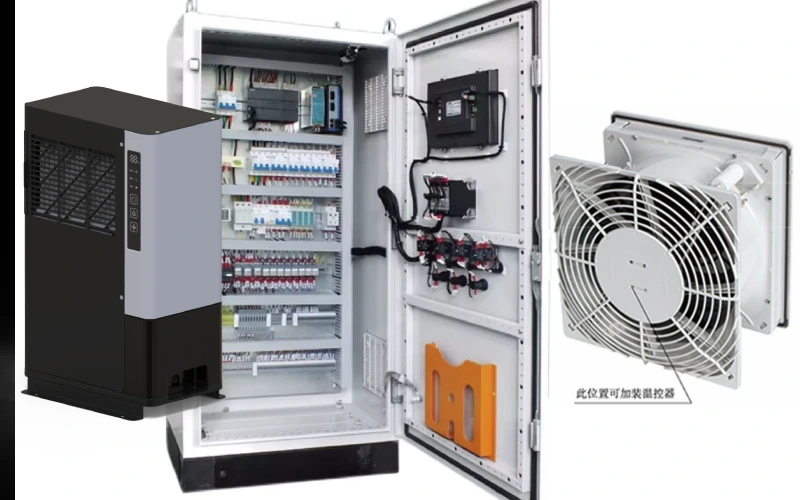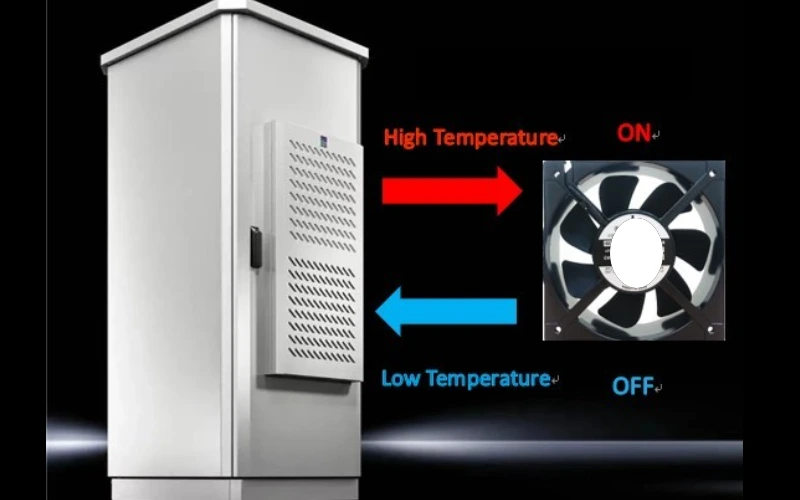Choosing the right fan can make a big difference in your industrial fans and cooling systems. When you compare a radial fan vs axial fan, you’ll notice each works best in different situations. For example, if you need to cool electrical cabinets or boost airflow in ventilation systems, axial fans handle high air volume at low pressure. On the other hand, radial fans deliver powerful, targeted air for high-pressure jobs. With Linkwell’s expertise, you can match the right fan to your needs.
Key Takeaways
- Radial fans excel in high-pressure situations, making them ideal for industrial tasks that require strong airflow against resistance.
- Axial fans are perfect for high-volume, low-pressure applications, such as cooling electrical cabinets and ventilating large spaces efficiently.
- Choosing the right fan depends on your specific needs; consider airflow direction, pressure requirements, and noise levels to make an informed decision.
- Regular maintenance, like cleaning blades and adjusting speed settings, can enhance fan performance and energy efficiency.
- Linkwell offers customizable fan options, ensuring you find the right fit for your project while saving on energy costs.
Radial Fan vs Axial Fan Overview
What Is a Radial Fan?
A radial fan, sometimes called a centrifugal fan, moves air by drawing it into the center and then pushing it outward at a right angle from the shaft. You’ll often see this type of fan in places where you need strong airflow against resistance, like in dust collection systems or industrial ventilation. Radial fans work best when you need high pressure but not necessarily a huge volume of air. They shine in tough environments where air needs to travel through filters, ducts, or other obstacles.
- Radial fans expel air outward from the center.
- They handle high-pressure, lower-volume tasks.
- You’ll find them in heavy-duty industrial fans for factories and workshops.
What Is an Axial Fan?
An axial fan moves air straight along its axis, just like a propeller. Air enters and exits the fan in the same direction, making it perfect for cooling electrical cabinets, telecom enclosures, or any space where you want to move a lot of air with little resistance. Axial fans are more energy-efficient in low-pressure, high-flow situations. They’re the go-to choice when you want to keep things cool and quiet.
- Axial fans push air parallel to their shaft.
- They excel at high-volume, low-pressure applications.
- You’ll see them in cooling systems, HVAC, and electronics.
Here’s a quick comparison to help you see the differences at a glance:
| Feature | Radial Fans | Axial Fans |
|---|---|---|
| Airflow Direction | Air enters at a right angle to the shaft | Air enters parallel to the shaft |
| Pressure | High pressure for industrial applications | Low pressure for broad area applications |
| Efficiency | Less efficient in low-pressure settings | More efficient in low-pressure, high-flow setups |
Tip: If you’re not sure which fan fits your project, Linkwell’s team can help you choose the right solution. With years of experience in industrial fans and ventilation, Linkwell offers expert advice and a wide range of customizable options for both radial and axial fan needs.
Difference Between Axial and Radial Fans

Airflow Patterns
When you look at the airflow characteristics of a radial fan vs axial fan, you’ll notice a big difference in how they move air. A radial fan pulls air in at a right angle to its shaft and then pushes it outward using centrifugal force. This design helps the fan handle air that needs to move through filters, ducts, or other obstacles. You’ll often see this type of fan in ventilation systems that need to push air against resistance.
On the other hand, an axial fan draws air in parallel to its shaft and sends it out in the same direction. The blades act like a propeller, moving large amounts of air quickly and efficiently. If you need to cool an electrical cabinet or keep air flowing in a telecom enclosure, an axial fan is usually the best choice. The difference between axial and radial fans in airflow patterns comes down to direction and purpose—radial fans excel at focused, high-pressure airflow, while axial fans shine in open spaces where you want to move a lot of air with little resistance.
Pressure and Volume
Let’s break down the pressure capabilities and air volume output in a radial fan vs axial fan comparison:
- Radial fans generate high pressure, making them perfect for long ductwork and tough industrial jobs.
- Axial fans deliver large volumes of air at low pressures, which works well for general ventilation.
- In open conditions, an axial fan can move up to 20 times more air than a radial fan of the same size.
If your project needs to push air through filters or long pipes, you’ll want the pressure capabilities of a radial fan. But if you need to cool a cabinet or ventilate a room, an axial fan will give you the airflow you need without using too much energy.
Efficiency and Noise
Efficiency and noise levels matter a lot when you choose between a radial fan vs axial fan. In most industrial settings, an axial fan is more energy efficient. It moves a lot of air while using less power, which helps you save on operational costs. Radial fans, though, are built for strength. They create powerful airflow for jobs that need extra force.
Noise levels can also influence your decision. Here’s a quick look at how each fan type compares:
| Fan Type | Noise Level Description |
|---|---|
| Radial | Tends to be noisier due to higher operational speed and friction within the housing. |
| Axial | Usually quieter, especially at lower speeds. |
If you need a quiet workspace, you’ll appreciate the low noise design of Linkwell’s axial fan. These fans keep things cool without adding extra sound, making them ideal for offices, telecom rooms, and sensitive environments. Plus, Linkwell’s focus on efficiency means you get reliable cooling with less energy use.
Tip: When you compare the difference between axial and radial fans, always consider your project’s needs for airflow, pressure, and noise. Linkwell’s team can help you find the right solution for your ventilation systems, whether you need high-pressure power or quiet, efficient cooling.
Axial Fan Features by Linkwell
Cooling Efficiency
You want your electrical cabinets and telecom enclosures to stay cool, right? Linkwell axial fans make that easy. These fans move a lot of air fast, so your equipment stays at a safe temperature. Many buyers have seen a 10°C drop in their workspace after switching to Linkwell axial fans. You get better airflow, fewer breakdowns, and more reliable cooling systems.
If you compare the power needed for 10,000 CFM, Linkwell axial fans use only 4 kW, while centrifugal fans need 8 kW. That means you save money and cut down on energy use.
Here’s a quick look at how Linkwell axial fans stack up:
| Metric | Linkwell Axial Fan | Centrifugal Fan |
|---|---|---|
| Initial Cost | $1,200 | $2,400 |
| Power for 10,000 CFM | 4 kW | 8 kW |
| Annual Energy at $0.10/kWh | $2,880 | $5,760 |
You get high performance without high costs.
Low Noise Design
Nobody likes a noisy fan in their workspace. Linkwell axial fans keep things quiet. The secret is in the design. Plastic blades cut down on noise, and ball bearings keep everything running smoothly. Advanced materials help airflow and reduce sound even more.
Check out these features:
| Design Feature | Contribution to Low Noise Operation |
|---|---|
| Plastic Blades | Reduces noise levels while enhancing airflow. |
| Ball Bearing Types | Ensures smooth operation, minimizing friction noise. |
| Advanced Material Tech | Enhances airflow efficiency and reduces overall noise. |
Many users say Linkwell axial fans are whisper-quiet, even after years of use. You can work, talk, or focus without distraction.
Durability and Energy Saving
You need fans that last. Linkwell axial fans use tough materials like stainless steel and UV-resistant plastics. These fans stand up to harsh conditions, from dusty factories to busy telecom rooms.
Linkwell axial fans also help you save on energy use. The latest models move more air with less electricity. You see lower bills and less wasted power.
You can pick from several series to match your needs. Want low noise and high protection? Try the LKA series. Need waterproof fans for outdoor cabinets? The LKE series works in extreme temperatures and even has automatic restart.
Linkwell axial fans come with top certifications for safety and quality:
| Certification | Description |
|---|---|
| UL | Underwriters Laboratories certification for safety. |
| CE | Compliance with international safety standards. |
| RoHS | Environmental compliance regarding hazardous substances. |
| CCC | China Compulsory Certification for product safety. |
You get peace of mind and reliable performance.
If you want to customize your axial fan, Linkwell offers options for speed, size, voltage, and more. You can even add fault alarms or branding.
With Linkwell axial fans, you get cooling, quiet, and savings—all in one package.
Radial Fan Applications
High-Pressure Needs
You might wonder where a radial fan really shines. If you work in industries that demand strong airflow against resistance, you’ll see radial fans everywhere. These fans push air with force, making them perfect for jobs that need high pressure. You’ll find them in cement plants, steel factories, and power stations. Radial fans help move air through filters, ducts, and other obstacles that would slow down other fan types.
Here’s a quick look at how different industries use radial fans for high-pressure tasks:
| Industry | Application Description |
|---|---|
| Cement Plants | Raw material prep, grinding, storage, blending, and waste gas removal |
| Steel Plants | De-dusting, sintering, and working in high dust and temperature conditions |
| Power Stations | Keeping boilers running smoothly, especially in plants below 500 MW |
| Chemical Industry | Exhausting hazardous gases, meeting strict safety standards |
| Textile Industry | Drying processes that need low pressure |
| Glass Industry | Cooling ovens and handling hot gases during glass making |
Radial fans keep these processes running safely and efficiently. You get reliable airflow even when the job gets tough.
Harsh Environments
Radial fans don’t just handle pressure—they also thrive in harsh environments. If you need a fan that works in dusty, hot, or dirty conditions, a radial fan is your best bet. These fans perform well when you have lots of obstacles, like filters or long ductwork. You won’t have to worry about reduced airflow or overheating.
Check out how radial fans compare to axial fans in tough settings:
| Fan Type | Performance in Harsh Environments |
|---|---|
| Radial | Handles high resistance, works well with filters and ducts |
| Axial | Best for low-pressure, high-volume airflow, struggles with obstacles |
You can trust radial fans to keep your cooling systems working, even when the environment gets rough. If you need to move air through a complicated setup or deal with extreme temperatures, a radial fan gives you the power and durability you need. You’ll see them in factories, chemical plants, and anywhere reliability matters most.
Tip: If your workspace faces dust, heat, or heavy resistance, consider using radial fans for long-lasting performance.
Axial Fans Applications
Industrial Cabinets
You see axial fans everywhere in industrial cabinets. These fans keep electrical panels, telecom racks, and automation systems cool. When you use Linkwell axial fans, you protect sensitive electronics from overheating. You also make sure your equipment runs smoothly.
Here are some common applications for axial fans in cabinets:
- HVAC systems circulate air and regulate temperature.
- Industrial ventilation removes fumes and airborne contaminants.
- Cooling electronic equipment prevents overheating in computers and servers.
- Agricultural setups control humidity and air quality in barns and greenhouses.
- Industrial processes maintain safe operations by removing pollutants.
- Refrigeration systems circulate air for better heat exchange.
- Power generation cools steam turbine condensers.
- Mining and tunnel ventilation provides fresh air and removes dust and gases.
- Exhaust fans remove air in kitchens and bathrooms.
- Sports arenas and large facilities ensure proper air circulation.
- Wind tunnels simulate wind conditions for testing.
You can rely on Linkwell axial fans for these typical uses. They work well in electrical distribution, telecom, automation, industrial machinery, and renewable energy.
Check out this table to see where you might use Linkwell axial fans:
| Industry |
|---|
| Electrical Distribution |
| Telecom |
| Automation |
| Industrial Machinery |
| Renewable Energy |
Clean Environments
Axial fans help you keep your workspace clean and safe. You want to avoid dust, fumes, and heat buildup. These fans move air efficiently, expelling hot air and airborne contaminants.
You get a healthier environment for metalworking, welding, or electronics assembly. Axial fans control dust and particles, so you meet safety regulations.
Here’s what you gain:
- Effective ventilation and exhaust systems.
- Comfortable and safe temperatures.
- Better control of dust and airborne particles.
Radial fans work best in high-pressure or harsh settings, but axial fans shine in clean environments. You get quiet operation and reliable airflow.
If you need to maintain clean air in energy, infrastructure, or robotics, Linkwell axial fans are a smart choice.
Tip: Choose axial fans for cabinets and clean rooms. You get efficient cooling, quiet operation, and a safer workspace.
Choosing the Right Fan
Key Factors
Picking the right fan for your project can feel tricky. You want to make sure you get the best airflow, pressure, and efficiency for your space. Start by looking at the main differences between axial and radial fans. Here’s a table to help you compare:
| Characteristic | Axial Fans | Radial Fans |
|---|---|---|
| Airflow Direction | Parallel to fan axis | Perpendicular to fan inlet |
| Pressure | Low | High |
| Airflow Volume | Large | Small |
| Energy Efficiency | High at high airflow | High at high pressure, low airflow |
| Suitable Applications | Ventilation, cooling towers, exhaust systems | Ductwork, filtration, dust collection |
You should think about your installation environment. Axial fans work best when you need to move a lot of air in open spaces, like cooling electrical cabinets or ventilating large rooms. Radial fans shine in high-pressure jobs, such as pushing air through long ducts or filters.
Here are some quick points to guide you:
- Radial fans: Great for high pressure and lower airflow. Use them in HVAC systems with lots of ducting, dust extraction, or industrial processes.
- Axial fans: Perfect for large airflows and low pressure. Choose them for general ventilation, cooling towers, and agricultural spaces.
Tip: Always check your space and airflow needs before making a decision. The wrong fan type can lead to poor performance and higher energy bills.
Practical Tips
You want your fan to run smoothly and save energy. Here are some easy ways to get the most out of your choice:
- Clean blades and housing often. Dust and dirt can slow down airflow.
- Pick the right size. A fan that’s too small won’t cool your space. One that’s too big wastes energy.
- Adjust speed settings to match your needs. Lower speeds save power when full airflow isn’t needed.
- Look for energy-efficient models. Fans with ENERGY STAR certification help cut costs.
You can also use smart controls to boost efficiency:
- Try PWM control for precise speed changes based on temperature.
- Use voltage control to adjust speed, though PWM works better.
- Add thermal sensors for automatic speed changes when things heat up.
- Use manual controls for quick tweaks in simple setups.
Note: Proper installation matters. Place your fan where it gets the best airflow. If you’re not sure, ask an expert for help. You’ll get better cooling and save money in the long run.
You now know the main differences between a radial fan and an axial fan. Check out this quick table to help you decide:
| Feature | Radial Fans | Axial Fans |
|---|---|---|
| Airflow and Pressure | High pressure, moderate airflow | Low pressure, high volume |
| Efficiency | Less efficient in low-pressure | More efficient in high-flow |
| Noise Levels | Noisier | Quieter |
| Maintenance | More complex | Easier |
If you need a radial fan for high-pressure or harsh environments, you get strong performance and durability. Radial fans use advanced materials and can handle up to 400 Pa pressure. For general cooling or clean spaces, axial fans work best. When you want expert advice and a wide product range, Linkwell gives you flexible customization, robust protection, and energy savings. Reach out to Linkwell for the right radial fan or axial solution for your project.
FAQ
How do I know which fan type fits my project?
You should check your airflow and pressure needs. Axial fans work best for high-volume, low-pressure jobs. Radial fans handle high-pressure tasks. If you feel unsure, ask Linkwell for advice.
Tip: Measure your space and equipment heat before you choose.
Can I customize Linkwell fans for my cabinet?
Yes, you can! Linkwell offers custom sizes, voltages, airflow rates, and filter types. You may even add your logo or special features. Just tell Linkwell what you need.
How often should I replace the fan filter?
You should replace filters every 3–4 months in dusty areas. In clean rooms, every 6 months works. Clean filters keep airflow strong and protect your equipment.
| Environment | Replacement Interval |
|---|---|
| Dusty | 3–4 months |
| Clean | 6 months |
Are Linkwell axial fans energy efficient?
Absolutely! Linkwell axial fans use optimized motors. You get up to 15% energy savings compared to regular models. Lower energy use means lower bills for you.
What certifications do Linkwell fans have?
Linkwell fans come with UL, CE, RoHS, and CCC certifications. You get safe, reliable products that meet international standards.




